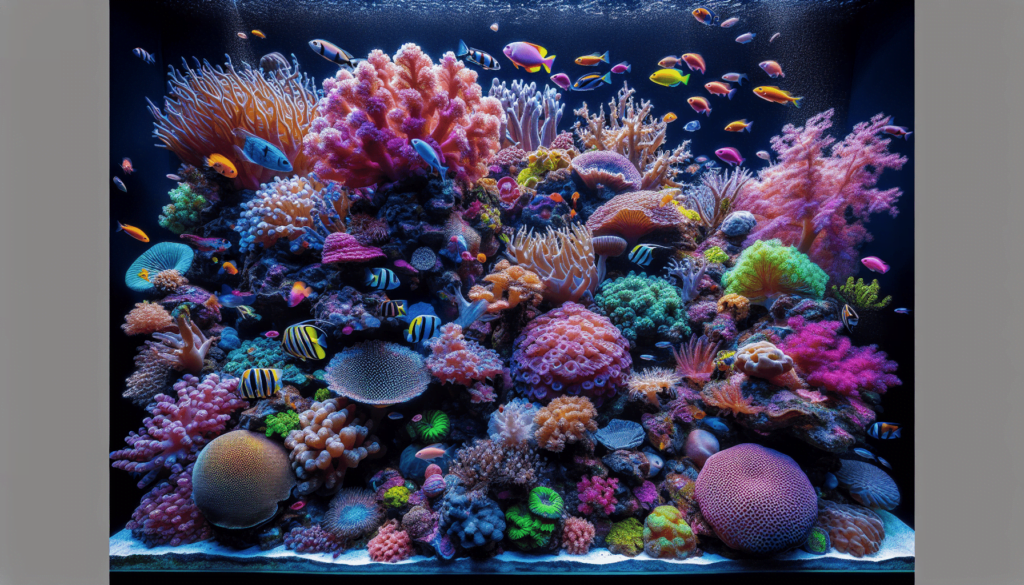In “Mastering Art in Aquascaping Reef Aquariums,” you get to dive into the magical world of creating beautiful underwater habitats. You’ll learn how to arrange colorful corals and lively fish in a way that makes your aquarium look like a real ocean scene. The article explores the history of this art form, explains current trends, and teaches you important techniques to get started. Imagine painting with living creatures and vibrant plants—this is what aquascaping reef aquariums are all about! Whether you’re a beginner or have some experience, this guide will help you master the skills needed to create your very own underwater masterpiece. Have you ever wondered what it would be like to create an underwater garden, full of colorful fish and vibrant coral reefs? If that sounds exciting, then you might be interested in Mastering the art of aquascaping reef aquariums.

What is Aquascaping?
Aquascaping is like gardening, but underwater. Instead of using soil and seeds, you use things like rocks, plants, and corals to create beautiful, underwater scenes. It’s a hobby that mixes creativity with science, and with a bit of practice, you can turn any fish tank into a stunning underwater world.
Why is Aquascaping Important?
Aquascaping isn’t just about making things look beautiful; it is also about creating a healthy environment for the fish and coral. A well-aquascaped tank can help fish feel more at home, reduce stress, and even improve their overall health.
A Brief History of Aquascaping
Did you know that aquascaping has been around for a long time? The roots of this practice can be traced back to Japan, where it’s called “Iwagumi,” which means “rock formation.” People in Japan used simple rocks and a few plants to create serene and balanced underwater landscapes. Over time, aquascaping has evolved, and now it includes all sorts of elements like driftwood, various types of plants, and colorful corals.
How Did Reef Aquariums Start?
Reef aquariums have a unique history too. Keeping corals and sea creatures in tanks began in the 19th century. Scientists and hobbyists wanted to study marine life up close. Over time, technology improved, making it easier to keep these delicate ecosystems alive and thriving at home.
Current Trends in Aquascaping
One of the cool things about aquascaping is that it’s always changing. People are coming up with new ideas and techniques all the time. Right now, there’s a big focus on sustainability. This means creating tanks that are not only beautiful but also environmentally friendly.
Sustainable Practices in Aquascaping
- Eco-friendly Materials: Using rocks and plants that are harvested responsibly.
- Recycling Water: Systems that clean and reuse water in the tank.
- Energy-efficient Lighting: LED lights that use less energy but make the tank look amazing.
Understanding Key Concepts
Before you dive into aquascaping, it’s important to know a few key terms and ideas. This will help you understand what you’re doing and why it’s important.
What is a Biotope?
A biotope is a small chunk of nature that has animals and plants living together in a balanced way. When you make a reef aquarium, you’re creating a mini-biotope. The goal is to make everything look natural—and also make sure the fish and plants can live happily together.
The Nitrogen Cycle
This is something every aquascaper needs to know about. The nitrogen cycle is how waste gets broken down in your tank. Fish produce waste, and this turns into something called ammonia, which can be harmful. Luckily, good bacteria in your tank can turn this ammonia into nitrite, and then into nitrate, which plants can use.
Lighting
Light is a critical element in both plant growth and overall tank health. Different plants and corals need different amounts of light. It’s like how some plants on land need full sun, while others are happy in the shade.

How to Start Your First Reef Aquarium
Ready to start your very own reef aquarium? Here’s a step-by-step guide to help you get started.
Step 1: Planning Your Tank
First, figure out what kind of look you want. Do you want it to be rocky like Japan’s Iwagumi style? Or full of corals and colorful fish? Planning helps guide your choices when you start buying things.
Step 2: Choosing Your Equipment
You’ll need some basic equipment to get started:
- Tank: The size of the tank can vary, but bigger is usually better for beginners.
- Filter: Keeps the water clean.
- Heater: Maintains the right temperature.
- Lights: Essential for plant and coral growth.
Here’s a simple table with the basic equipment you might need:
| Item | Purpose |
|---|---|
| Tank | The main home for your fish and plants |
| Filter | Keeps the water clean and safe |
| Heater | Maintains a stable temperature |
| Lights | Helps plants and corals grow |
| Test Kits | Measures water quality |
| Substrate | Serves as the ground layer |
Step 3: Setting Up the Tank
Before you add water, place your substrate (ground covering) in the tank. This could be sand or gravel, depending on what kind of look you’re going for. Then, add your rocks or driftwood. Try to create caves and hiding spots for fish.
Step 4: Adding Water and Plants
Slowly add water to the tank so you don’t disturb your substrate too much. After that, you can start planting your aquatic plants. These will help keep your water clean and provide hiding spaces for fish.
Step 5: Cycling the Tank
Remember the nitrogen cycle we talked about? You’ll need to “cycle” your tank before adding any fish. This means letting the tank run for a while to build up those good bacteria.
Step 6: Introducing Fish and Corals
Once your tank is cycled, you can start adding fish and corals. Remember to introduce them slowly so they have time to adjust to their new home.
Case Studies in Aquascaping
Now let’s look at some examples of well-done aquascaping projects.
Example 1: The Iwagumi Style
John, a hobbyist from Japan, created an Iwagumi-style tank at home. He used three main rocks and a few smaller ones to create a simple but beautiful underwater scene. He added some hardy plants and let the tank cycle for a month. When he finally added his fish, they had plenty of hiding spots, and he could tell they were happy and healthy.
Example 2: The Coral Reef Tank
Samantha set up a coral reef tank that mimicked a tiny slice of the ocean. She used live rock, which already had good bacteria on it. She picked corals that were beginner-friendly and added some colorful fish like clownfish and gobies. By carefully monitoring the water quality and making sure she had the right lighting, Samantha’s tank thrived.

Comparing Different Aquascaping Styles
When it comes to aquascaping, there are many styles to choose from. Each has its own unique features and challenges.
| Style | Features | Challenges |
|---|---|---|
| Iwagumi | Simple rock formations | Requires precise balance |
| Dutch | Focus on plant variety | Needs lots of plant care |
| Jungle | Looks wild and natural | Can become overgrown quickly |
| Reef | Full of corals and fish | Monitoring water chemistry |
What Each Style Brings to the Table
- Iwagumi: Simplicity and balance. It’s elegant but requires careful planning.
- Dutch: A variety of plants. It’s like an underwater garden but needs a lot of maintenance.
- Jungle: Natural and wild. Easier to set up but can become messy.
- Reef: Colorful and lively. Very rewarding but demands attention to water chemistry.
Impact of Different Perspectives
Creating a beautiful and healthy aquarium takes time and effort. Each style has its strengths and weaknesses, and the best one for you depends on what you like and how much time you want to spend caring for it.
Balancing Aesthetics and Health
It’s important to remember that while making your tank look good is fun, keeping the fish and plants healthy should always come first. Sometimes, you might need to make changes to keep everything in balance.

The Future of Aquascaping
Aquascaping is becoming more popular every year, and there are exciting trends and technologies on the horizon.
Future Trends
Here are some things to look forward to:
- Smart Tanks: These use technology to monitor water quality and make adjustments automatically.
- Advanced Lighting: Lights that can mimic natural sunlight, encouraging better plant and coral growth.
- Sustainable Practices: As people become more aware of the environment, expect to see more eco-friendly materials and methods.
Implications for Hobbyists
These new developments will make it easier for beginners to get started and for experienced aquascapers to push the limits of what they can create. As technology improves, keeping a beautiful and healthy reef aquarium will become simpler and more accessible.
Conclusion
Creating a beautiful reef aquarium is like painting a living piece of art. It takes patience, creativity, and a little bit of science. By understanding the basics of aquascaping, choosing the right equipment, and carefully planning your tank, you can create a stunning underwater world that both you and your fish will love.
Final Thought
So, are you ready to dive into the world of aquascaping and create your own underwater masterpiece? Start small, learn as you go, and most importantly, have fun!
Engagement
Have you ever tried creating a reef aquarium or another type of aquascape? Share your experiences or ask questions in the comments below. And if you found this article helpful, don’t forget to share it with your friends!
Credible Sources
- “The Complete Guide to Aquascaping” by George Farmer
- “Aquarium Designs Inspired by Nature” by Peter Hiscock
- www.reedaquariumhub.com
- www.fishtankadviser.com
Feel free to explore these sources for more detailed information and techniques to master the art of aquascaping reef aquariums.




